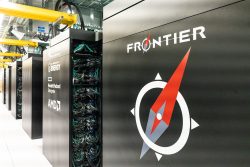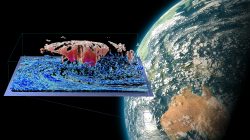
Focused on the accuracy of climate predictions, a computational team led by Sandia National Laboratories recently achieved a major milestone with a cloud-resolving model they ran on Frontier, the world's first exascale supercomputer.

The world's fastest supercomputer, Frontier at Oak Ridge National Laboratory, has reached 1.1 exaflops, breaking the exascale speed barrier - a threshold of a quintillion calculations per second.
(Photo by Calos Jones, Oak Ridge National Laboratory) Click on the thumbnail for a high-resolution image.
"We have created the first global cloud-resolving model to simulate a world's year of climate in a day," said Sandia researcher Mark Taylor, chief computational scientist of the Energy Exascale Earth System Model, or E3SM, an eight-lab project supported by the Department of Energy's Office of Science for the development of advanced climate models. "We're ushering in a new era of accuracy."
The E3SM model simulates critical aspects of Earth's climate system that might impact conditions in the United States in the coming decades, including extreme temperatures, droughts, floods and a rise in sea level.
Clouds play a critical role in Earth's climate system, impacting weather patterns and precipitation. "Traditional Earth system models struggle to represent clouds accurately," Taylor said. "This is because they cannot simulate the small overturning circulation in the atmosphere responsible for cloud formation and instead rely on complex approximations of these processes."
The E3SM group developed an improved cloud-resolving atmosphere model named SCREAM, for Simple Cloud Resolving E3SM Atmosphere Model. "This next-generation program has the potential to substantially reduce major systematic errors in precipitation found in current models," Taylor said, "because of its more realistic and explicit treatment of convective storms and the atmospheric motions responsible for cloud formation."

Snapshot from a cloud-resolving E3SM simulation showing a tropical cyclone off the west coast of Australia. The global view shows clouds where the condensed water content is greater than 0.1 g per kilogram. The inset shows a 3D cross section with ice mass in red and liquid cloud structure in blue." (Graphic by Brad Carvey) Click on the thumbnail for a high-resolution image.
But the new model by itself was not enough. Running a simulation that resolves clouds globally over many decades requires tremendous computing resources to run in a reasonable amount of time. An exascale computer, executing more than a quintillion calculations per second - that's the numeral 1 followed by 18 zeros - was just what was needed.
Frontier, built under DOE auspices at Oak Ridge National Laboratory, fills that bill, with more than 9,000 compute nodes. An E3SM team at Sandia worked to ensure SCREAM would run well on Frontier, other GPU-based systems and more conventional CPU-based supercomputers.
Frontier is expected to become a production-ready machine later this year and is just now starting to open for general users. Through the DOE's Exascale Computing Project, the E3SM developers had a 10-day window to test the performance of the new SCREAMv1 model running at a global 3.25-kilometer resolution. They obtained record-setting performance, with the atmosphere component running at greater than a simulated year per day.
SCREAM's GPU performance, coupled with the exascale machine, for the first time will enable multi-year climate simulations with a more accurate treatment of clouds, leading to more accurate predictions of future weather and climate.
Sandia National Laboratories is a multimission laboratory operated by National Technology and Engineering Solutions of Sandia LLC, a wholly owned subsidiary of Honeywell International Inc., for the U.S. Department of Energy's National Nuclear Security Administration. Sandia Labs has major research and development responsibilities in nuclear deterrence, global security, defense, energy technologies and economic competitiveness, with main facilities in Albuquerque, New Mexico, and Livermore, California.






